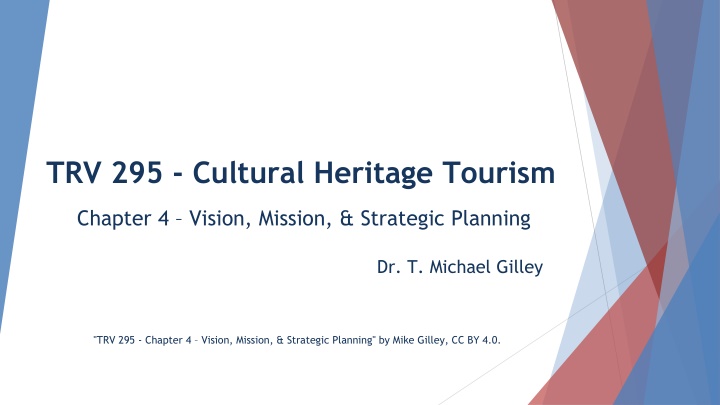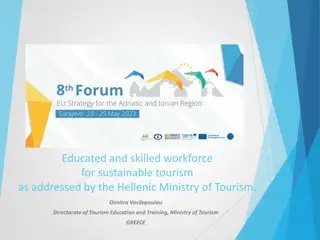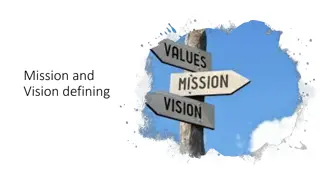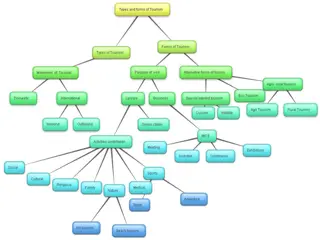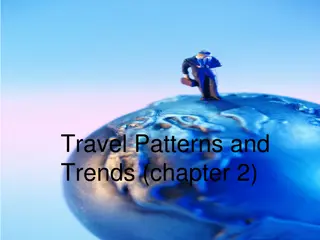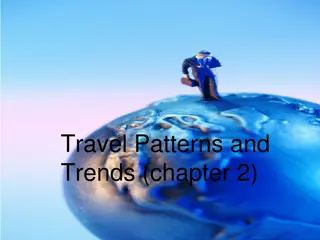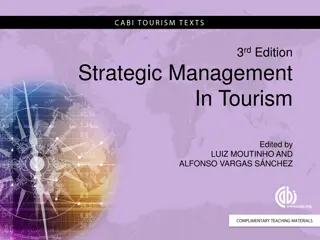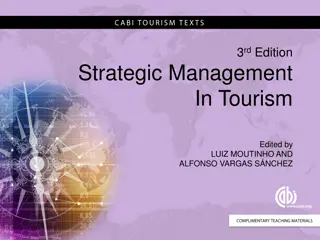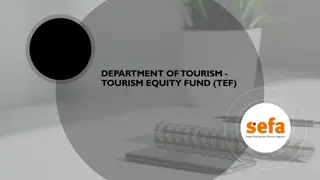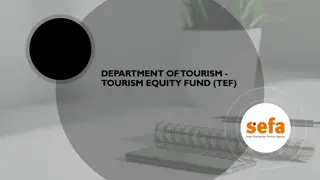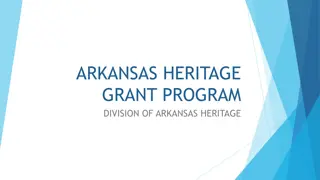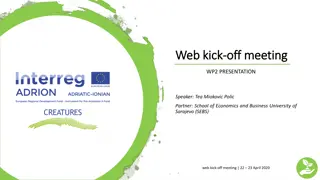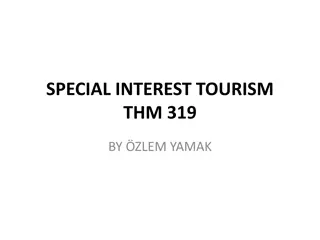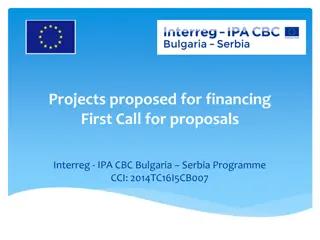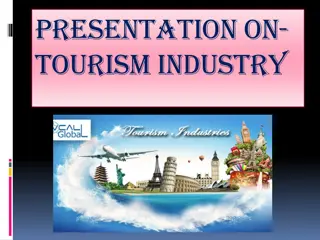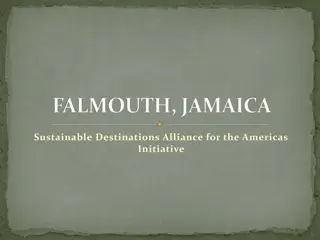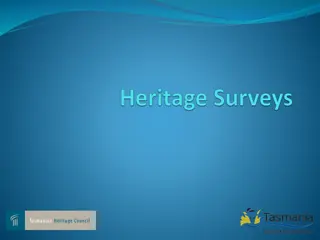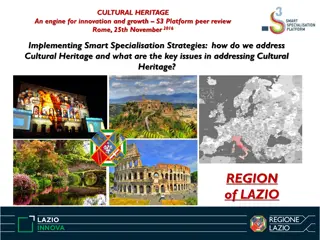Achieving Balance in Cultural Heritage Tourism: Vision and Mission Statements
Explore the importance of vision and mission statements in cultural heritage tourism, focusing on achieving a balance between preservation, authentic representation, and economic development. Learn from case studies such as The Blue Ridge Institute & Museum, Home Craft Days Festival, and MerleFest to understand how vision and mission statements shape the direction and purpose of cultural heritage events.
Download Presentation

Please find below an Image/Link to download the presentation.
The content on the website is provided AS IS for your information and personal use only. It may not be sold, licensed, or shared on other websites without obtaining consent from the author.If you encounter any issues during the download, it is possible that the publisher has removed the file from their server.
You are allowed to download the files provided on this website for personal or commercial use, subject to the condition that they are used lawfully. All files are the property of their respective owners.
The content on the website is provided AS IS for your information and personal use only. It may not be sold, licensed, or shared on other websites without obtaining consent from the author.
E N D
Presentation Transcript
TRV 295 - Cultural Heritage Tourism Chapter 4 Vision, Mission, & Strategic Planning Dr. T. Michael Gilley "TRV 295 - Chapter 4 Vision, Mission, & Strategic Planning" by Mike Gilley, CC BY 4.0.
Achieving a Balance Between Cultural Heritage Preservation and Authentic Representation and Tourism Economic Development To focus all activities on preservation, authentic representation, and economic development for a cultural heritage tourism event, include these elements in either the vision or mission statement which drives all activities of the organization and its daily operations. Having this focus of the vision or mission statements will guide administrators and employees when writing annual goals, objective, and activities keeping this balance central to the organization s core.
Vision of the Cultural Heritage Event A vision statement is a road map showing where the company wants to be in the future. Case Study 1 The Blue Ridge Institute & Museum of Ferrum College documents, interprets, and presents the folk heritage of the Blue Ridge region (Blue Ridge Institute & Museum, 2008). Case Study 2 The Home Craft Days Festival of Mountain Empire Community College festival serves as an integral part of the College s longstanding commitment to promoting and preserving the rich musical and cultural heritage of Southwest Virginia (Home Craft Days, 2018). Case Study 3 - MerleFest of Wilkes Community College serves as the primary fundraiser for the WCC Endowment Corporation, funding scholarships, capital projects and other educational needs through the celebration of Traditional plus music (MerleFest, 2018). What is the vision statement of your cultural heritage case study?
Mission of the Cultural Heritage Event A mission statement is a brief statement of the purpose of the cultural heritage event. Case Study 1 the mission of the Blue Ridge Folklife Festival is to celebrate the traditional crafts, music, foods, storytelling, horse handling skills, dog training skills, and moonshine folklore of Virginia s Blue Ridge region. Case Study 2 the mission of the Home Craft Days Festival is to celebrate the traditional crafts, music, dance, foods, and storytelling of the coalfield and surrounding areas of southwest Virginia. Case Study 3 the mission of the MerleFest is to raise funds for the Wilkes Community College Endowment Corporation for funding scholarships, capital projects, and other educational needs through the celebration of traditional plus music, a unique mix of music based on the traditional, roots-oriented sounds of the Appalachian region, including bluegrass and old-time music, and expanded to include Americana, country, blues, rock and many other styles. What is the mission statement of your cultural heritage case study?
Goals, Objectives, and Activities = the Strategic Plan of the Cultural Heritage Event A goal is a brief statement of what is to be accomplished to achieve the vision and mission. An objective is a defined target to be accomplished within a specified time frame with specified results. An activity statement is the condition of creating or doing something. The written goals, objectives, and activities comprise a strategic plan of an organization for fulfilling its mission to support the vision. The completion of activities move an organization toward the fulfillment of an objective. And the completion of objectives move an organization toward the fulfillment of goals. Strategic plans can be written to serve a year to five years in the life of an organization. They are generally reviewed and revised annually. The strategic plans of a cultural heritage tourism event should address the preservation of authentic culture as well as the economic development of the community(s) served.
Goals Some sample goals for a cultural heritage tourism festival could be: to identify the musicians for the types of music to be presented at the festival; to identify expenses for having specific musicians perform at the festival; to identify sponsors to pay the expenses for specific musicians to perform at the festival; to create a sponsorship campaign to contact potential sponsors and arrange a specific level of sponsorship; and To make arrangements to collect sponsorship funds and pay the music performers, etc. What are some of the goals for that the cultural heritage event of your case study? Do they specifically address the vision and mission for the event?
Objectives Some sample objectives for a cultural heritage event could be: To fulfill six hours of music performance for four stages, the music coordinators of the cultural heritage music festival will identify six old time music groups, six bluegrass groups, six gospel groups, and six blues groups within one year of the scheduled date of the festival. To accommodate various levels of sponsorship, the budget committee will create musical categories of sponsorship levels with specific funding amounts to support the music performers within a month after the musicians and their performance expenses have been identified. To identify sponsors for the music performances, the budget committee will work with the Festival Foundation Board within a month of establishing levels of sponsorship. What are some of the objectives for that the cultural heritage event of your case study? Do they specifically address the goals of the strategic plan for the event?
Activities Some activities or tasks for the objectives of a cultural heritage event could be: The budget committee will develop a proposed budget based upon information gained from various other festival committees working with needs for site, equipment, performers, etc. within eleven to ten months before the festival. The budget committee with work with the Festival Foundation Board to identify potential sponsors for the established levels of sponsorship. The budget committee members will work with the Festival Foundation Board and volunteers to form teams to visit potential donors with information about the festival and discuss their support. Does your case study have activities written for their objectives? If so, what are they? Do they specifically address the objectives of the strategic plan for the event?
Assignment for Week 4 Identify / write the vision statement for the cultural heritage event case you are studying. Identify / write the mission statement for the cultural heritage event case you are studying. Identify / write two goals with objectives and activities for the cultural heritage event case you are studying.
Resources Blue Ridge Institute and Museum. (2008). Blue Ridge Institute and Museum: About. Retrieved from http://www.blueridgeinstitute.org/about.htm Home Craft Days (2018). About Home Craft Days. Retrieved from http://www.homecraftdays.org/about/ McNamara, C. (n.d.). Basics of writing and communicating a strategic plan. Retrieved from https://managementhelp.org/strategicplanning/writing- plan.htm MerleFest. (2018). About MerleFest. Retrieved from http://merlefest.org/about-merlefest/
